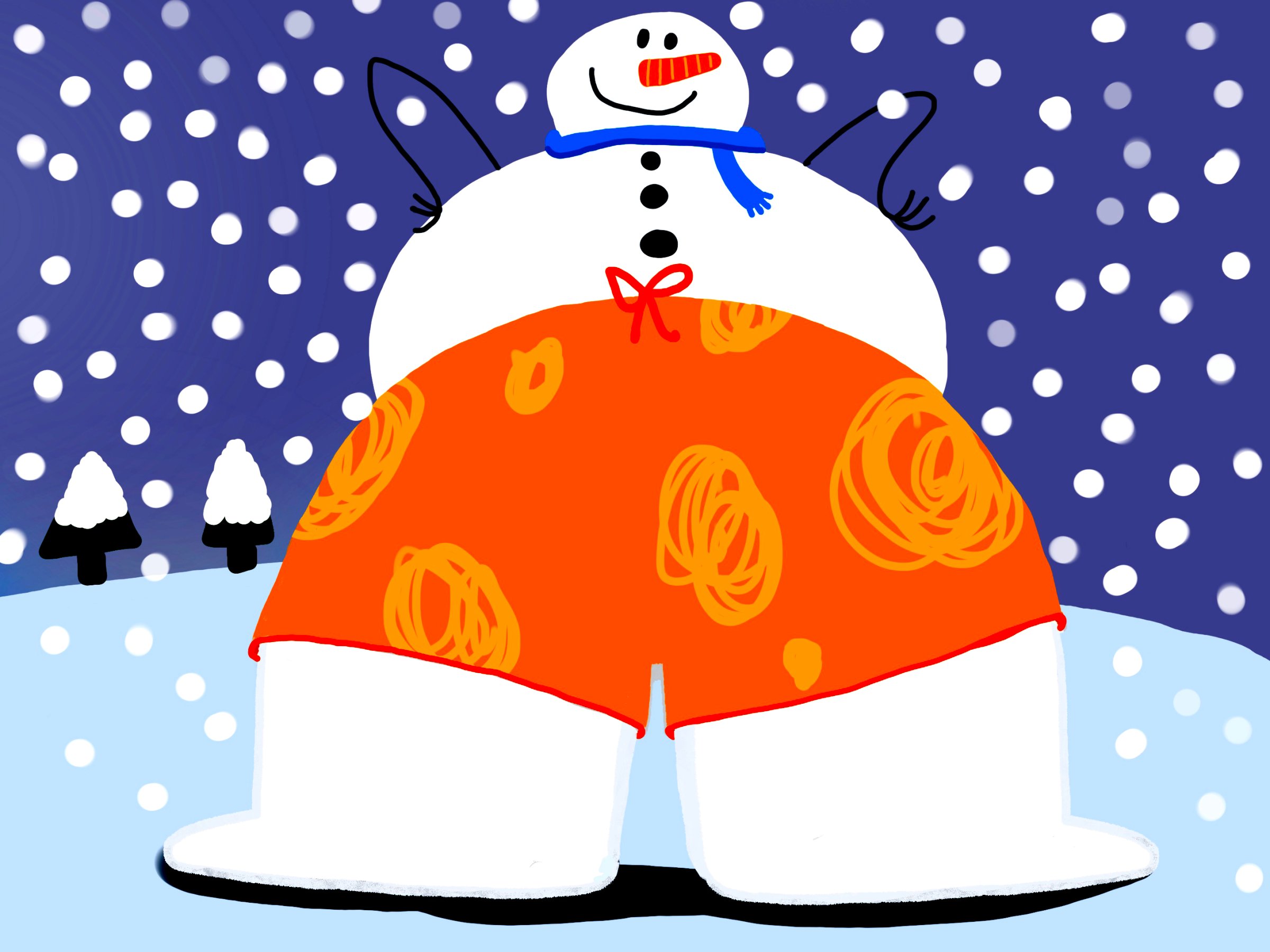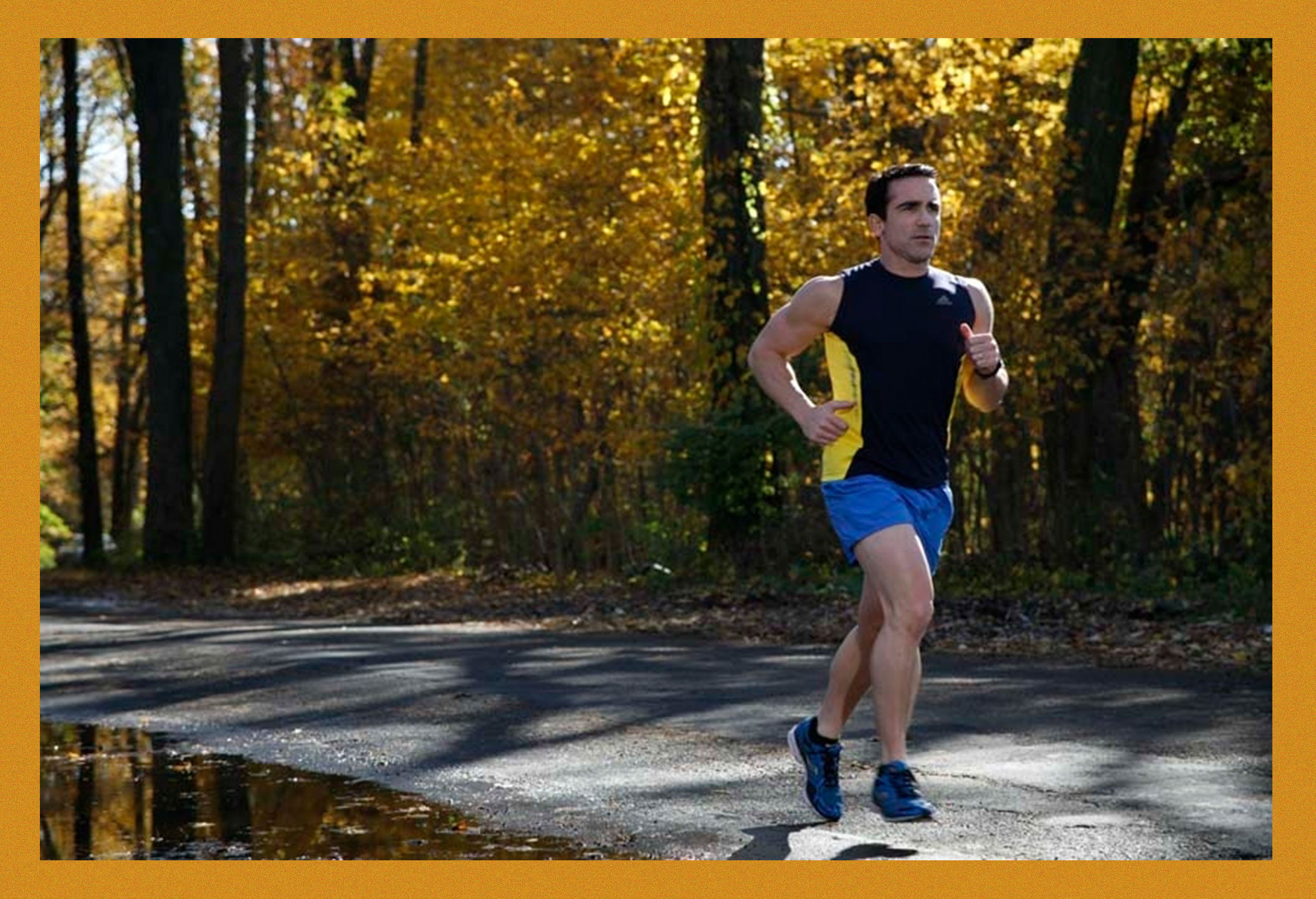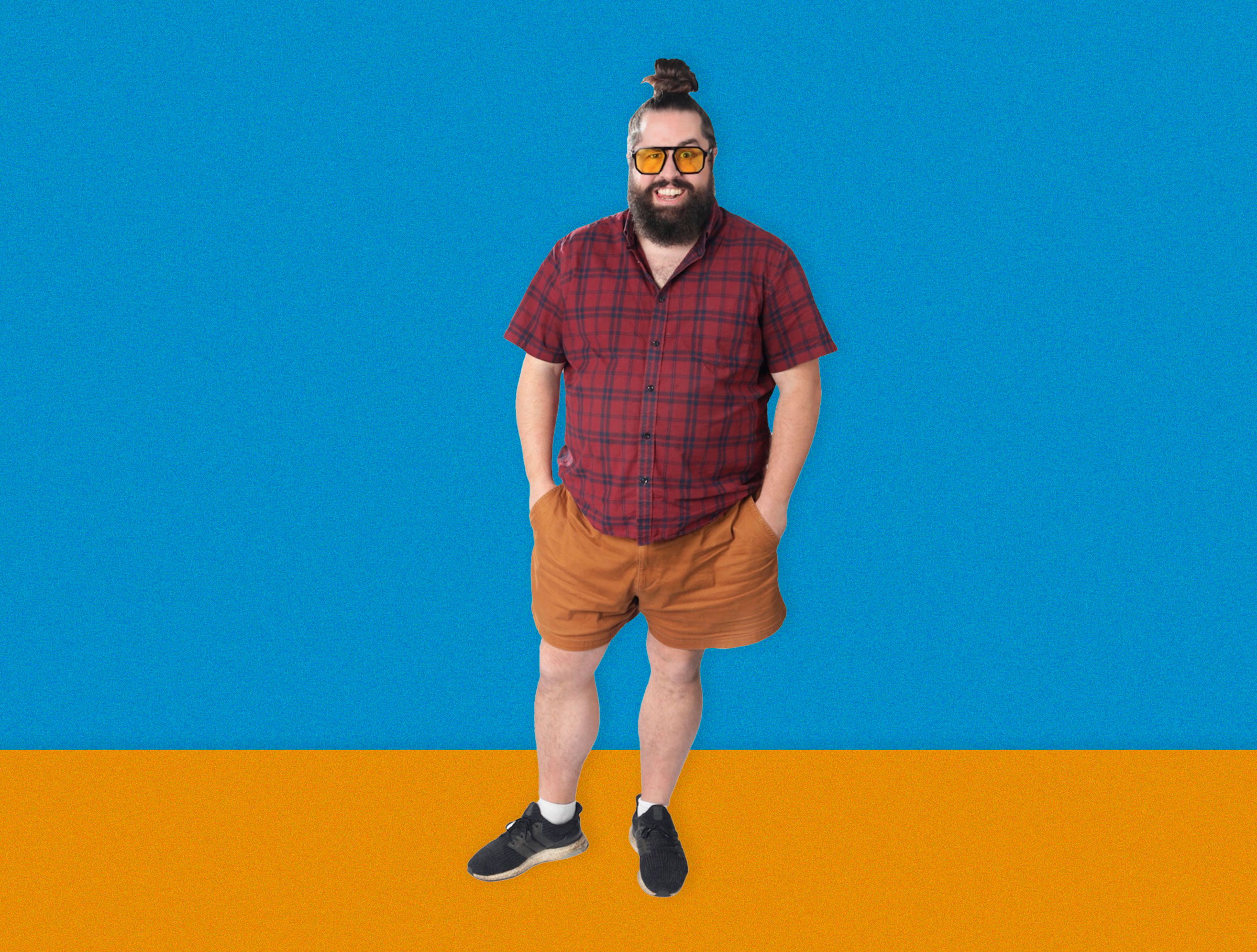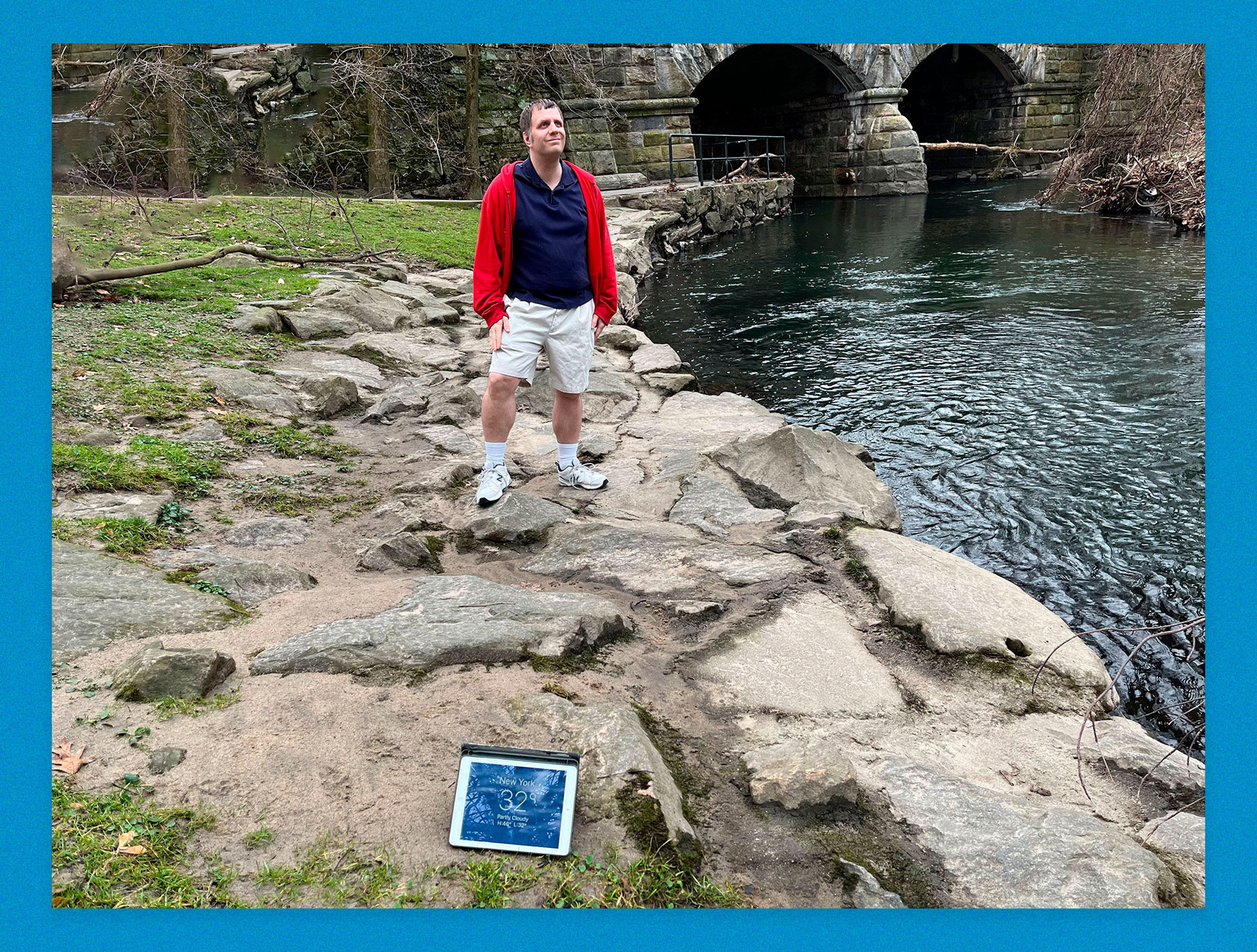
When Tom Holland, a 54-year-old exercise physiologist, shovels snow at home in Connecticut, someone always starts shouting at him. A neighbor—lots of neighbors, actually—will drive by, roll down the window, and ask: “Really? You’re in shorts?”
Holland is, in fact, in shorts, as he is 364 other days of the year. He’s been wearing them in all temperatures since he was a kid—maybe for attention at first, he admits, but now because he runs hot and is simply more comfortable pantsless. He’s in shorts when he walks his two dogs, goes for a run in below-freezing temps, or cleans his at-home outdoor ice rink in the dead of night. He wears them to his kids’ wintertime ice-hockey games—a sharp juxtaposition to his wife, who stays warm with a battery-operated heated vest. Holland almost always forgoes jackets, too. “I’d rather be a little bit cold most of the time than hot all the time,” he says.
Everyone seems to know a cold-weather shorts guy. He stands out on sidewalks otherwise populated by people in parkas. He’s parading around every college campus and taking a lap around every snow-covered cul de sac. There’s even one in the Senate. So as Holland’s neighbors want to know: Why does their wardrobe stay the same when the seasons change? And aren’t they cold?

A flurry of psychological forces
There’s no single reason why some people—usually men—like wearing shorts in chilly weather. The habit could be driven by a desire to demonstrate toughness or masculinity, says Carolina Estevez, a psychologist based in Austin; shorts guys might assume others will be impressed by their ability to tolerate punishing temperatures. Or it could be a way to make a statement and express themselves in a unique way. “It sets them apart from others and makes them memorable, reinforcing their sense of individuality,” she says. Some are likely drawn to novel and intense experiences and get a thrill out of braving the cold. Once they develop a reputation for wearing shorts year-round, they might continue doing so to avoid cognitive dissonance, Estevez says—the mental discomfort triggered by behaving in ways that contradict our perceptions about ourselves.
More From TIME
Ryan McCormick, who’s 45 and splits his time between New York and North Carolina, wears shorts every day and has found that being able to withstand the arctic chill increases his mental and physical fortitude. (He slips into a jacket if he’s going to be outside for a long time, but otherwise sticks to shorts and a T-shirt regardless of the weather.) “I use this as a means to condition my body,” he says. “I’m testing myself and seeing how long I can take it.” Personal growth, he believes, is the result of persevering through discomfort—he doesn’t want to get too cozy in any aspect of life.
Philadelphia psychologist Lauren Napolitano says her husband also wears shorts year-round—the result, she believes, of his chronic optimism and perpetual good mood. “In his mind, it’s never really that cold,” she says. “Some people just have this disposition where they don’t see obstacles—they have a sunny temperament.” It might not melt the snow, but it helps shield them against its harshness.
In pursuit of comfort—and fashion
Some people are born better able to tolerate the cold than others, says Dr. Clayton Cowl, an occupational medicine specialist at the Mayo Clinic in bitterly cold Rochester, Minn. “There’s probably something to the genetics of it that we aren’t quite certain of,” he says. Research suggests that body temperature varies from person to person, and some men simply get warm quickly, based on factors like age, body weight, stress levels, and lifestyle habits. Women, meanwhile, tend to have colder hands and feet by a few degrees. Plus, they usually have less muscle mass and a lower metabolic rate than men, which makes their baseline temperature chillier.
Cold-weather shorts guys may simply run hot. Stephen Triplett, 56, sports shorts year-round, even when the temperature plummets below 0 degrees Fahrenheit in Bozeman, Mont. He doesn’t like wearing pants, and since he works inside, he usually only experiences a few chilly minutes a day. “I’d much rather be comfortable eight or 10 hours a day inside than stuck in jeans,” he says. He claims he’s not bothered by the cold—most of the time. Once he took his kids swimming at a hotel and, afterwards, went outside in shorts and flip-flops to heat up the car. It was about 25 degrees below zero Fahrenheit, and his hair was wet. “In that moment you think, ‘Oh my gosh, I might die,’” he says. “Then you turn on the car and blast the heater and by the time you get home, you’re like, ‘Oh man, I’m so glad I didn’t pull jeans on over my swimsuit.’”
Read More: 9 Ways to Reset Your Relationship With Social Media
Triplett’s preference attracts a lot of comments. Enough people have asked him what would happen if his car broke down in the cold that he now keeps a blanket in the trunk. Once, an older man, similarly dressed, approached him in the grocery store and asked if people teased him, too. Mostly, though, neighbors slow down when he’s shoveling snow in shorts and remark on what a “tough guy” he is. “I don’t know if it’s sarcasm or admiration, but I choose to assume the best,” he says.
Another member of the shorts-are-more-comfortable camp, Josh Weaver, 34, now lives in Los Angeles. It’s easy to wear shorts every day there, but his proclivity dates back to time he spent growing up in the Midwest, including going to college in Michigan. Jeans feel too tight on his thighs and calves, he says, so he’s turned shorts into a fashion statement. He owns about 15 to 20 pairs of athletic shorts, 10 “dress” shorts, a few pairs of jean shorts, and several suits that consist of short-sleeve blazers and shorts. “Shorts have this weird connotation of being less than—literally because they’re less than pants,” he says. “But there’s a way to have respectable shorts, as long as it matches the situation and the attire.” And if he encounters anyone who’s offended by his wardrobe choices? “If you have a problem looking at my knees, tell me,” he says. “I have no problem putting on some joggers.”

Is wearing shorts in the cold safe?
There’s no threshold for when it becomes too cold to wear shorts outside. For the most part, strutting around in shorts isn’t dangerous, says Cowl, the Mayo Clinic doctor, especially since many shorts guys wear a jacket or at least a sweatshirt to keep their torso warm.
“It’s very rare that you see someone come in to get treated for frostbite,” Cowl says. If these bare-legged folks are exerting energy—perhaps jogging or shoveling—their core body temperature increases, ensuring they don’t get too cold. Some should tread carefully, though, he advises: Kids don’t tend to have the decision-making skills to determine what’s best for them, and people with conditions like peripheral neuropathy, who don’t have strong feeling in their limbs, may not realize they’ve been outside for too long.
Read More: How to Be a Healthier Drinker
In general, your body will tell you if it’s too cold, Cowl says. Are your extremities turning red or pale? Are you shivering uncontrollably? In extreme cases, someone might start to feel confused or pass out. Use common sense, he says, and go inside—or put on some pants—at the first sign of suffering.
If you’re still concerned about the shorts-wearer in your life, take comfort in the fact that some eventually reform. Adam Bertocci, who’s 41 and based in Bronxville, N.Y., considers himself a recovering cold-weather shorts guy. Starting at a young age, he would wear shorts well past the time of year when others began covering their legs. “[It’s] an easy way to prove yourself,” he says. “You don’t have to be the best; you don’t have to win. You just need to show up, endure, and never give in.” Back then, wearing shorts during winter was a harmless way for good kids to rebel, he recalls—plus, after the fifth time that someone asks you if you’re cold, a certain stubbornness kicks in, ensuring the shorts stay on. “It becomes a label you embrace,” he says. “Because why not?”

Well, wind chills and polar vortexes, for starters. Somewhere around his second year at Northwestern University in Evanston, Ill.—where it can get colder than the Arctic—the frigid temps overwhelmed Bertocci. He recalls walking four to six blocks to an off-campus comic-book store, and feeling like he’d morphed into a snowman. “It defeated me,” he says. “That place crushed my shorts-in-the-winter spirit more effectively than any other facet of adulthood.”
He still keeps his pants-wearing to a minimum, though. Bertocci doesn’t like to be too warm, and jokes that he’s more likely to retire to Calgary than to Florida. “The truth is, guys aren’t that complicated,” he says. “If our internal temperatures were all to shift, we’d change our clothes to accommodate it—even if that meant throwing away every amusing side benefit to being this guy.”
More Must-Reads from TIME
- How Donald Trump Won
- The Best Inventions of 2024
- Why Sleep Is the Key to Living Longer
- Robert Zemeckis Just Wants to Move You
- How to Break 8 Toxic Communication Habits
- Nicola Coughlan Bet on Herself—And Won
- Why Vinegar Is So Good for You
- Meet TIME's Newest Class of Next Generation Leaders
Contact us at letters@time.com